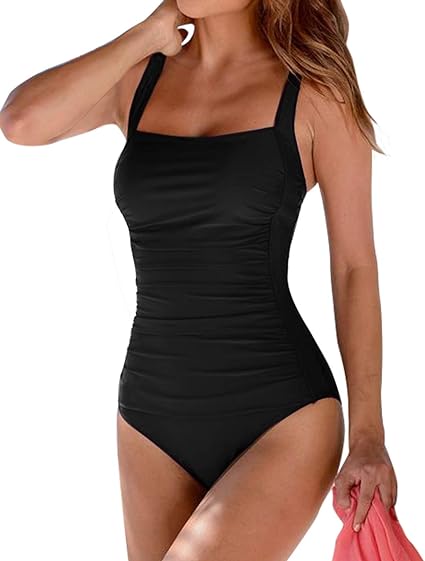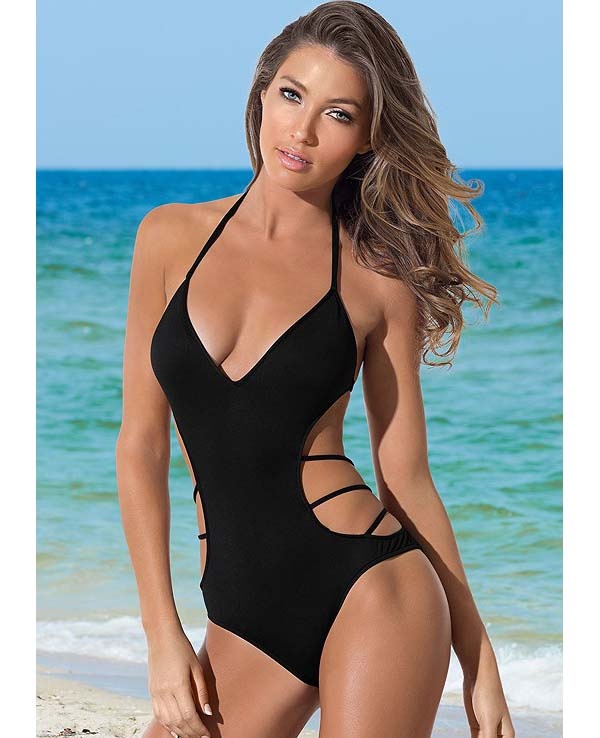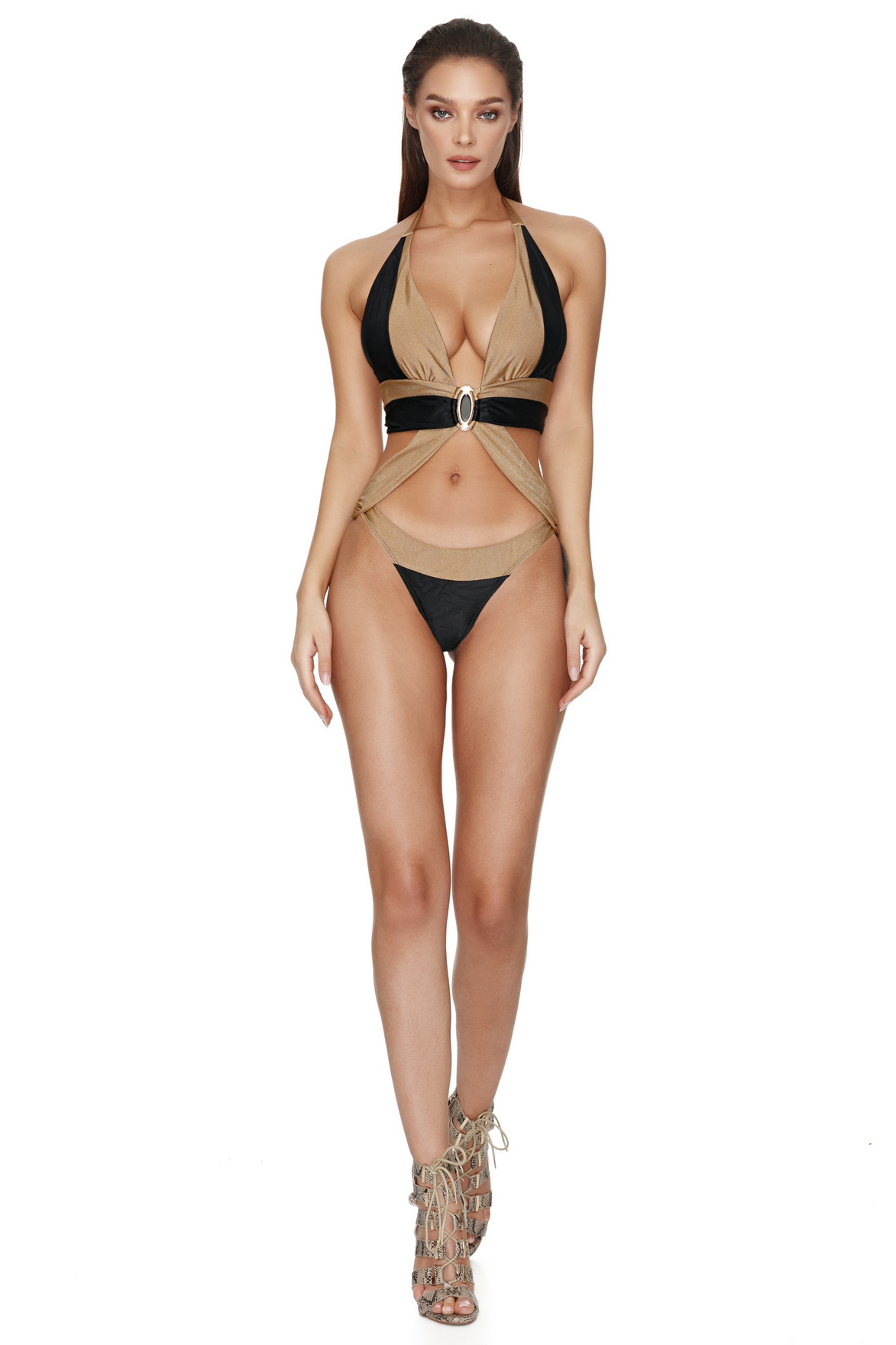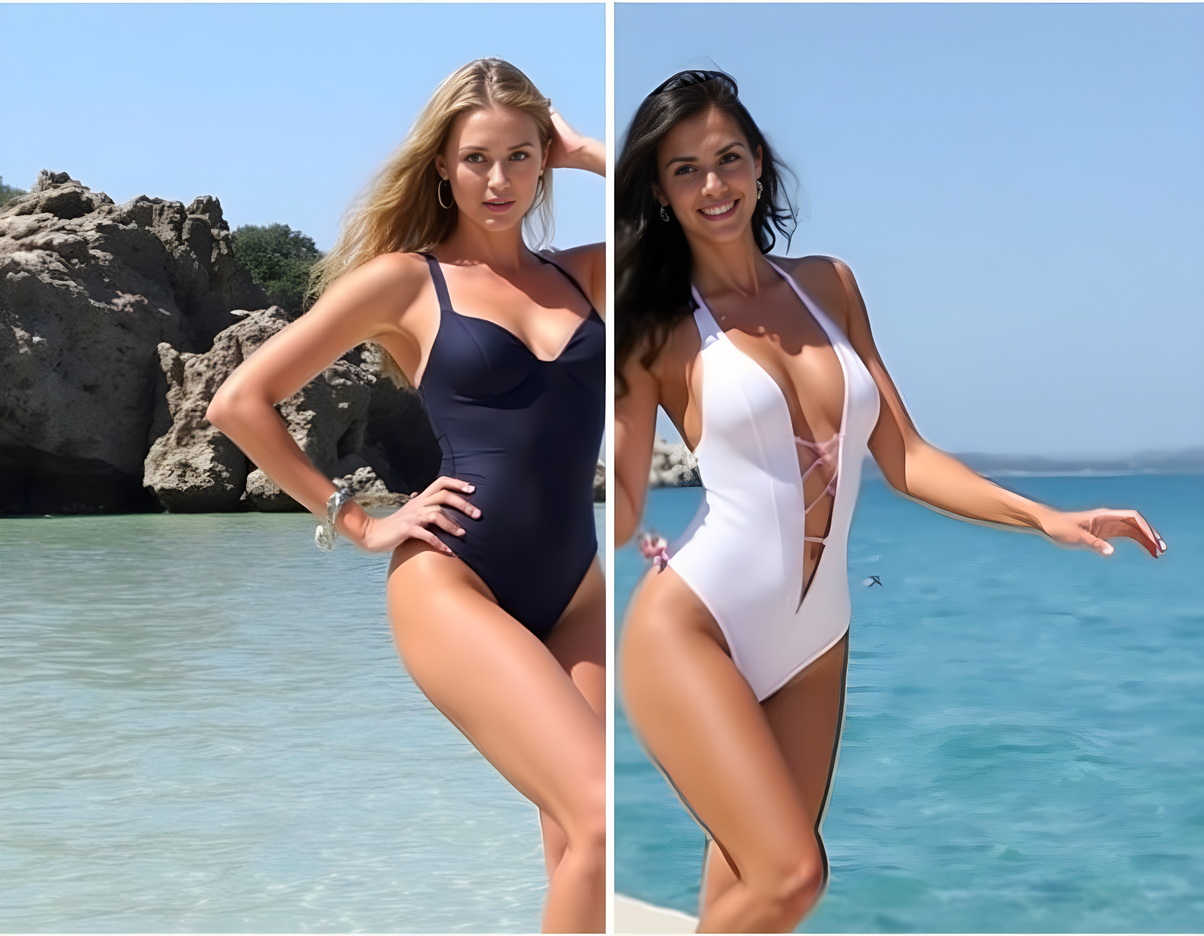Content Menu
● Understanding One-Piece Swimsuits
>> The Evolution of the One-Piece
● Introducing the Monokini
>> The Origin and Evolution of the Monokini
● Comparing Monokinis and One-Piece Swimsuits
● Choosing Between a Monokini and a One-Piece
● Styling Tips for Monokinis and One-Piece Swimsuits
● Caring for Your Swimwear
● Video: Styling One-Piece Swimsuits
● Conclusion
● Frequently Asked Questions
>> Q: Can monokinis provide as much support as one-piece swimsuits?
>> Q: Are monokinis suitable for all body types?
>> Q: Can one-piece swimsuits be as fashionable as monokinis?
>> Q: Are monokinis appropriate for family-friendly beaches or public pools?
>> Q: How do I choose between a monokini and a one-piece if I'm self-conscious about my midsection?
When it comes to swimwear, the choices can be overwhelming. From bikinis to tankinis, the options seem endless. However, two styles that often cause confusion are the monokini and the one-piece swimsuit. While both offer more coverage than a traditional bikini, they have distinct characteristics that set them apart. In this comprehensive guide, we'll explore the differences between monokinis and one-piece swimsuits, their histories, and how to choose the right style for your body type and personal preferences.
Understanding One-Piece Swimsuits
One-piece swimsuits have been a staple in women's swimwear for decades. These classic designs offer full coverage of the torso, typically extending from the chest to the hips or upper thighs. One-piece swimsuits are known for their versatility and ability to flatter various body types.
Key Features of One-Piece Swimsuits:
1. Full torso coverage
2. Various neckline options (e.g., scoop neck, V-neck, halter)
3. Different back styles (e.g., open back, high back)
4. Range of leg cuts (e.g., high-cut, boy short)
5. Optional features like tummy control panels or built-in bras
One-piece swimsuits are often favored for their practicality and comfort. They're suitable for a wide range of activities, from leisurely beach days to more active water sports. Many women appreciate the security and confidence that comes with wearing a one-piece, especially in situations where they want to avoid wardrobe malfunctions or feel more modest.

The Evolution of the One-Piece
The one-piece swimsuit has a rich history dating back to the early 20th century. In the Victorian era, women's swimwear was cumbersome and restrictive, often consisting of multiple layers of fabric. As societal norms evolved and women became more involved in sports and leisure activities, the need for more practical swimwear arose.
In the 1920s, the modern one-piece swimsuit began to take shape. Australian swimmer Annette Kellerman played a significant role in popularizing a more form-fitting, single-piece design. Her revolutionary swimsuit, which resembled a unitard, caused quite a stir but paved the way for more functional and stylish swimwear.
Throughout the decades, the one-piece swimsuit has undergone numerous transformations. In the 1950s, Hollywood icons like Marilyn Monroe and Esther Williams popularized glamorous, curve-enhancing styles. The 1960s and 1970s saw the rise of bold prints and daring cuts, while the 1980s introduced high-cut legs and vibrant colors.
Today, one-piece swimsuits come in an incredible variety of designs, from retro-inspired looks to modern, athletic styles. They continue to be a popular choice for women of all ages and body types, offering a perfect balance of style and functionality.
Introducing the Monokini
Now that we've explored the one-piece swimsuit, let's turn our attention to its more daring cousin: the monokini. The monokini is a unique hybrid that combines elements of both one-piece and two-piece swimsuits, offering a bold and fashion-forward alternative to traditional swimwear.

Key Features of Monokinis:
1. Strategic cutouts or openings in the torso area
2. Connected top and bottom sections
3. Various levels of coverage, from minimal to more modest
4. Often features unique design elements like straps, ties, or hardware
5. Can create the illusion of a two-piece from certain angles
Monokinis are designed to make a statement. They offer the coverage of a one-piece in some areas while revealing skin in others, creating a tantalizing balance between modesty and allure. The cutout designs can vary greatly, from small peek-a-boo openings to large sections that expose the midriff or sides.
The Origin and Evolution of the Monokini
The term "monokini" has an interesting history. It was originally coined in 1964 by Austrian-American fashion designer Rudi Gernreich, who created a topless swimsuit that consisted only of the lower part of a bikini. This provocative design caused a sensation and was considered highly controversial at the time.
However, the modern interpretation of the monokini is quite different from Gernreich's original concept. Today's monokinis are not topless but rather feature strategic cutouts or openings in a one-piece silhouette. This evolution reflects changing attitudes towards swimwear and the desire for designs that push the boundaries of fashion while still providing a level of coverage and support.

Over the years, monokinis have become increasingly popular, especially among fashion-forward beachgoers and those looking to make a statement with their swimwear. Designers have embraced the style, creating an array of monokini designs that cater to different tastes and comfort levels.
Comparing Monokinis and One-Piece Swimsuits
Now that we've explored both monokinis and one-piece swimsuits individually, let's compare them side by side to better understand their differences and similarities.
1. Coverage:
◆ One-Piece: Typically offers full coverage of the torso, from chest to hips or upper thighs.
◆ Monokini: Provides partial coverage with strategic cutouts or openings in the torso area.
2. Design:
◆ One-Piece: Can range from simple, classic styles to more elaborate designs with ruching, patterns, or embellishments.
◆ Monokini: Often features more complex designs with cutouts, straps, or unique structural elements.
3. Versatility:
◆ One-Piece: Suitable for a wide range of activities and body types; often considered more practical for swimming and water sports.
◆ Monokini: Generally more suited for sunbathing, lounging, or making a fashion statement; may be less practical for active water activities.
4. Support:
◆ One-Piece: Usually offers more overall support, especially for the bust and tummy areas.
◆ Monokini: Support can vary depending on the design; some styles may offer less bust support due to cutouts.
5. Body Types:
◆ One-Piece: Flattering for a wide range of body types and can help smooth and shape the figure.
◆ Monokini: Can be particularly flattering for those wanting to highlight certain areas while providing coverage in others.
6. Tan Lines:
◆ One-Piece: Creates more uniform tan lines.
◆ Monokini: Can create unique tan patterns due to cutouts and straps.

Choosing Between a Monokini and a One-Piece
Selecting the right swimwear is a personal decision that depends on various factors. Here are some considerations to help you choose between a monokini and a one-piece swimsuit:
1. Body Confidence: If you're comfortable showing more skin and want to make a bold statement, a monokini might be the perfect choice. If you prefer more coverage or feel more confident with your midsection covered, a one-piece could be ideal.
2. Activity Level: Consider what activities you'll be doing in your swimwear. For active water sports or swimming laps, a one-piece typically offers more security and support. For lounging by the pool or sunbathing, a monokini can be a stylish option.
3. Body Shape: Both styles can be flattering for different body types. One-pieces are great for creating a smooth silhouette, while monokinis can accentuate your best features through strategic cutouts.
4. Personal Style: Think about your overall style and what makes you feel confident. If you love making fashion statements, a monokini might align better with your personality. If you prefer classic, timeless looks, a one-piece could be more your speed.
5. Occasion: Consider where you'll be wearing the swimsuit. A monokini might be perfect for a beach party or resort vacation, while a one-piece could be more appropriate for family gatherings or public pools.
6. Tan Lines: If you're concerned about tan lines, keep in mind that monokinis will create more unique patterns due to their cutout designs.
7. Support Needs: If you require more bust support or prefer tummy control features, many one-piece styles offer these benefits. Some monokinis also provide support, but it can vary greatly depending on the design.
Styling Tips for Monokinis and One-Piece Swimsuits
Whether you choose a monokini or a one-piece, there are numerous ways to style your swimwear for both beach days and beyond. Here are some tips:
1. For Monokinis:
◆ Pair with high-waisted shorts or a flowy skirt for a chic beach-to-bar look.
◆ Add a sheer cover-up to create an alluring layered effect.
◆ Accessorize with statement jewelry to complement the unique design of your monokini.
◆ Choose wedge sandals or strappy flats to elongate your legs.
2. For One-Piece Swimsuits:
◆ Wear with wide-leg pants or a maxi skirt for an elegant poolside outfit.
◆ Layer under a blazer with shorts for a sophisticated yacht club ensemble.
◆ Add a wide-brimmed hat and oversized sunglasses for a classic, glamorous look.
◆ Pair with a wrap skirt or sarong for easy beach-to-lunch transitions.
Caring for Your Swimwear
To ensure your monokini or one-piece swimsuit stays in great condition, follow these care tips:
1. Rinse in cool water after each use to remove chlorine, salt, or sand.
2. Hand wash in cool water with a mild detergent designed for delicates.
3. Avoid wringing or twisting the fabric; instead, gently squeeze out excess water.
4. Lay flat to dry in a shaded area, away from direct sunlight.
5. Rotate between multiple swimsuits to allow each one to fully dry and recover its shape between wears.
Video: Styling One-Piece Swimsuits
To help you visualize how versatile one-piece swimsuits can be, here's a helpful video showcasing various styling tips:
This video demonstrates how to create multiple outfits using one-piece swimsuits, which can be applied to both traditional one-pieces and monokinis. The stylist shows how to pair swimsuits with different bottoms, accessories, and cover-ups to create looks suitable for various occasions.
Conclusion
The difference between monokinis and one-piece swimsuits lies primarily in their design and the amount of skin they reveal. While one-piece swimsuits offer full torso coverage and are often more practical for a range of activities, monokinis provide a daring alternative with their strategic cutouts and unique designs.
Both styles have their place in the world of swimwear, catering to different preferences, body types, and occasions. Whether you choose the classic elegance of a one-piece or the bold statement of a monokini, the most important factor is that you feel comfortable and confident in your choice.
Remember, swimwear is not just about following trends or conforming to certain ideals. It's about expressing your personal style, feeling good in your own skin, and enjoying your time in and around the water. Whether you prefer the full coverage of a one-piece or the alluring design of a monokini, there's a perfect swimsuit out there for everyone.

Frequently Asked Questions
Q: Can monokinis provide as much support as one-piece swimsuits?
A: While some monokinis can offer good support, especially in the bust area, they generally provide less overall support compared to one-piece swimsuits due to their cutout designs. However, the level of support can vary greatly depending on the specific style and construction of the monokini.
Q: Are monokinis suitable for all body types?
A: Monokinis can be flattering on various body types, but the key is finding a style that complements your figure. Some monokinis can accentuate curves, while others can create the illusion of a longer torso. It's important to try different styles to find what works best for your body shape and personal comfort level.
Q: Can one-piece swimsuits be as fashionable as monokinis?
A: Absolutely! One-piece swimsuits come in a wide variety of stylish designs, from retro-inspired looks to modern, sleek styles. Many feature unique elements like mesh inserts, interesting back designs, or bold prints that make them just as fashionable as monokinis.
Q: Are monokinis appropriate for family-friendly beaches or public pools?
A: The appropriateness of monokinis can depend on the specific design and the norms of the location. Some monokinis with minimal cutouts may be suitable for family settings, while more revealing styles might be better suited for adult-oriented beaches or private pools. Always consider the environment and any dress codes when choosing your swimwear.
Q: How do I choose between a monokini and a one-piece if I'm self-conscious about my midsection?
A: If you're concerned about your midsection, a one-piece swimsuit might offer more coverage and confidence. Look for styles with ruching, tummy control panels, or strategic color blocking to flatter your figure. However, some monokini designs feature cutouts in areas that can actually accentuate your best features while providing coverage where you want it most. The key is to try on different styles and choose what makes you feel most comfortable and confident.




































































